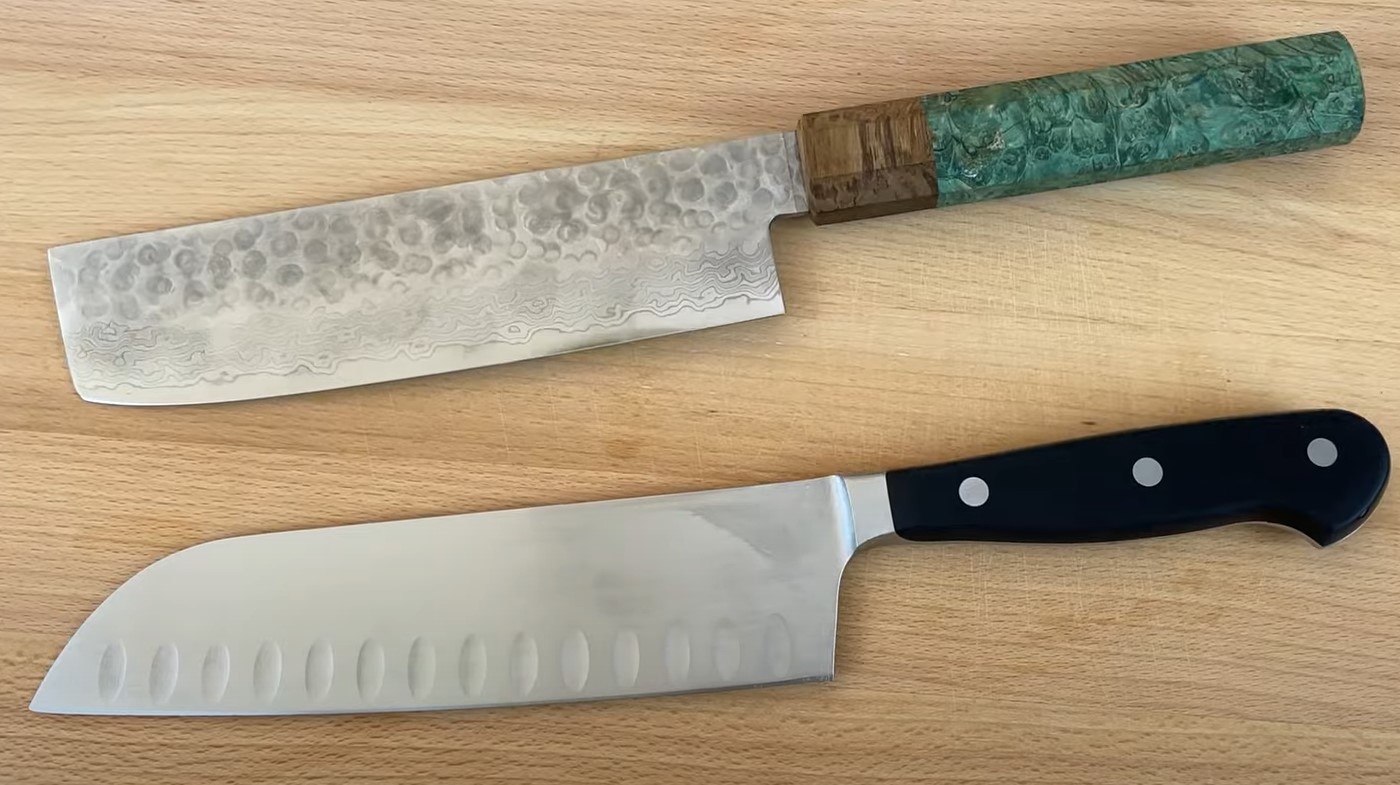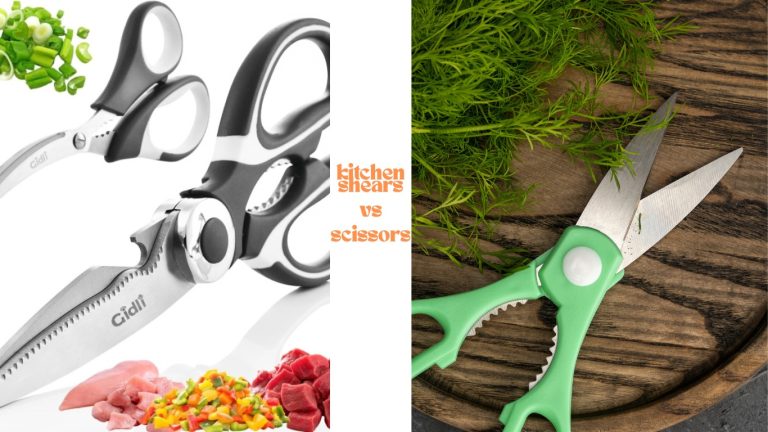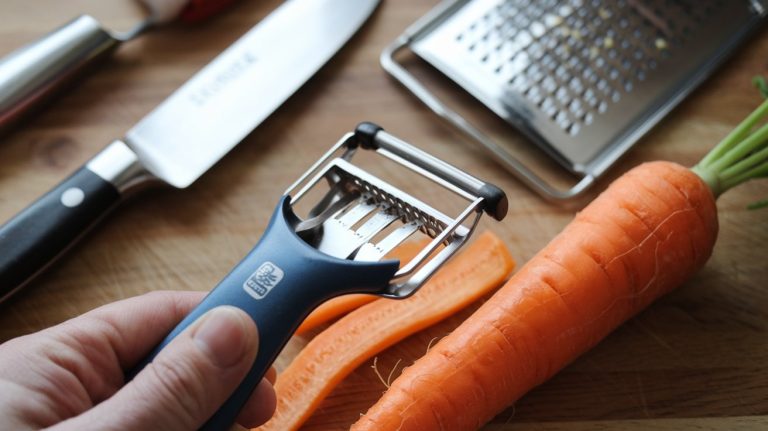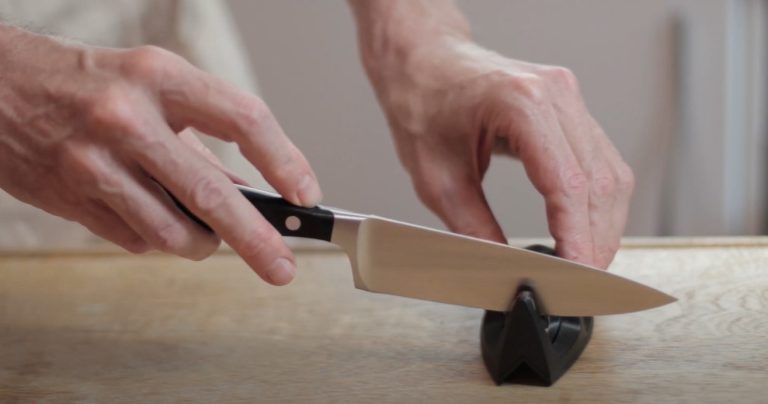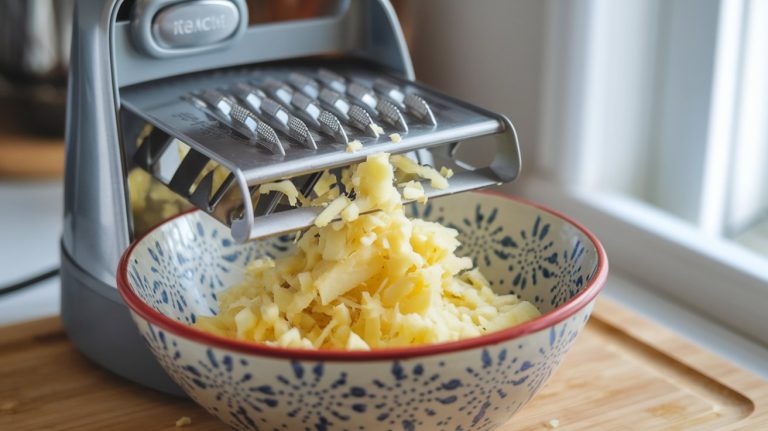Nakiri Knife vs Santoku Knife: Chop Like a Pro
When choosing between a Nakiri and a Santoku knife, you’ll notice key differences. The Nakiri’s flat, cleaver-like blade excels at precise vegetable slicing, ideal for carrots and celery with its up-and-down chopping motion.
The Santoku, with its curved tip, is a versatile all-purpose tool for veggies, fish, and boneless meats, handling various cutting techniques.
Both offer sharp, durable edges, but which fits your kitchen best? Stick around to uncover deeper insights.
Key Takeaways
- Nakiri has a rectangular, flat-edged blade ideal for precise vegetable cuts, while Santoku’s curved tip suits versatile tasks.
- Nakiri excels in up-and-down chopping for veggies, whereas Santoku handles chopping, slicing, and rocking motions.
- Nakiri weighs 4-6 ounces, perfect for veggie prep; Santoku at 5.5-7.5 ounces offers power for denser foods.
- Nakiri targets home cooks focused on plant-based diets; Santoku is an all-purpose choice for Asian cuisine.
- Both knives use high-hardness steels (HRC 58-65+), ensuring sharpness, with handle options affecting control and comfort.
Blade Design and Shape Comparison
As you immerse yourself in the world of Japanese knives, you’ll quickly notice the striking differences in blade design between the Nakiri and Santoku.
The Nakiri boasts a rectangular, cleaver-like shape with a straight, flat edge and a blunt, squared-off tip. Its tall, thin blade offers knuckle clearance, and the spine runs parallel to the edge for precise cuts.
The Nakiri’s rectangular, cleaver-like design features a flat edge and blunt tip, ensuring precision with its tall, thin blade and ample knuckle clearance.
In contrast, the Santoku features a “Sheepsfoot” shape, with a spine curving down to a rounded, pointed tip. Its edge, mostly straight, has a subtle curve near the tip, while the wide blade also guarantees clearance.
Though both are lightweight, the Santoku’s slightly heavier, tapered design contrasts the Nakiri’s uniform height, showcasing their distinct craftsmanship. Additionally, the Nakiri’s design is specifically optimized for chopping and slicing vegetables with precise cutting techniques.
Primary Functions and Specializations
Beyond the distinct blade designs of the Nakiri and Santoku, you’ll find their true differences shine in how they perform specific tasks.
When you’re prepping meals, the Nakiri’s your go-to for vegetable mastery, delivering precise chops and uniform slices with its flat, thin blade.
Meanwhile, the Santoku offers incredible versatility, tackling veggies, fruits, fish, and boneless meats with ease as a true all-purpose tool. Its thinner blade allows for easier gliding through food, making every cut smooth and effortless.
Imagine yourself in the kitchen with these knives:
- Nakiri: Slicing through a pile of vibrant greens, the straight edge guarantees clean cuts, preserving every bit of flavor.
- Santoku: Dicing tender chicken, its wide blade scoops up pieces effortlessly.
- Both: Handling soft tofu, you’ll appreciate their precision on delicate tasks.
Cutting Techniques and Motions
When you grab a Nakiri knife, you’ll notice its straight, flat edge encourages a precise up-and-down chopping motion, making full contact with the board for clean, separated vegetable slices.
Switch to a Santoku, and you’ve got a blade with a subtle curve near the tip, letting you tackle versatile techniques like chopping, slicing, and even a gentle rocking motion for herbs.
Let’s explore how these distinct motions shape your cutting experience with each knife. The Nakiri’s design, ideal for vertical cuts, ensures precision in slicing vegetables with minimal effort due to its straight edge and thin blade.
Nakiri Chopping Motion
If you’re diving into the world of Japanese knives, you’ll quickly notice that the Nakiri knife‘s chopping motion sets it apart with its unique, purposeful design.
With its flat, straight edge, you’re encouraged to use a vertical up-and-down chop, perfect for slicing through tough produce like squash without the accordion effect.
Master the push-cut technique by starting near the tip and pushing diagonally for precise, thin vegetable strips. This method minimizes follow-through, making it easier on wrists compared to other knives.
Imagine yourself mastering these motions:
- Vertical Chop – Slam straight down, letting the flat blade make full board contact.
- Push Cut – Glide forward and down, crafting delicate slices with ease.
- Tap Mincing – Gently tap herbs, preserving their flavor with minimal bruising.
Santoku Versatile Techniques
As you explore the world of Japanese knives, you’ll find the Santoku knife shines with its remarkable versatility, living up to its name, which translates to “three virtues.”
This all-purpose tool, developed in Japan during the 1940s and 50s, blends Western and Japanese designs to excel at slicing, dicing, and mincing.
Master its downward-and-forward push cut for precise, clean slices of veggies or fish—lift the blade between cuts for uniformity.
For dicing, make parallel then perpendicular cuts; for mincing herbs, try a swift up-and-down chop or gentle rocking motion with the tip as pivot.
Use a pinch grip for control and a claw grip to protect fingers.
With its wide blade, you’ll scoop ingredients effortlessly!
Its ergonomic design also reduces hand fatigue during extended cutting tasks.
Materials and Construction Details
As you explore the world of Nakiri and Santoku knives, you’ll notice distinct blade material choices like high-carbon and stainless steels, each offering unique benefits in sharpness and durability.
You’ll also find handle design options ranging from traditional Japanese Wa-handles to ergonomic Western styles, crafted from woods or composites for comfort and grip.
Beyond that, pay attention to weight and hardness—Japanese steels often hit 60-67 HRC, ensuring a razor edge but varying in heft to suit your cutting style.
Understanding the blade profile is crucial, as the Nakiri’s flat edge excels at precise vegetable chopping, while the Santoku’s flatter design aids in balanced slicing for various ingredients flat edge excels.
Blade Material Choices
When exploring the world of Japanese knives like the Nakiri and Santoku, you’ll quickly discover that blade material plays a pivotal role in performance and maintenance. The steel type impacts sharpness, durability, and care needs, so choosing wisely is key.
Nakiri knives often feature high-carbon or Damascus steel for precision, while Santoku knives lean toward stainless or high-carbon stainless steel like VG-10 for versatility.
Japanese steel’s renowned precision and quality enhance the cutting experience for both types of knives. Carbon steel options, often used in Nakiri, require regular oiling to prevent rust formation and maintain their razor-sharp edges.
Consider these material distinctions:
- High-Carbon Steel: Think Shirogami or Aogami—razor-sharp edges but rust-prone, demanding diligent care.
- Stainless Steel: Options like AUS-8 or VG-10 resist corrosion, balancing sharpness with low maintenance.
- Powdered Steel: SG2 offers extreme hardness and edge retention, ideal for long-lasting performance.
Handle Design Options
Explore the world of handle design, and you’ll find that the grip of a Nakiri or Santoku knife is just as essential as its blade.
Immerse yourself in the choice between the traditional Japanese Wa-handle, with its hidden tang and lightweight feel, or the Western Yo-handle, featuring a full tang and riveted scales.
Wa-handles, often made of odorless Magnolia wood, offer precise control with shapes like octagonal or D-shaped for a secure grip.
Meanwhile, Yo-handles, crafted from composites like Pakkawood or premium woods like Mahogany, provide stability with contoured ergonomics.
Handle material and shape significantly impact comfort and durability, enhancing your overall cooking experience with each use material affects durability.
Whether you prefer the pinch grip of a Wa-handle or the firm hold of a Yo-handle, your choice shapes your cutting experience with every slice.
Weight and Hardness
Moving from the grip of your knife to its core build, let’s focus on how weight and hardness shape the performance of Nakiri and Santoku knives.
You’ll notice Nakiri knives are often lighter, weighing 4-6 ounces, ideal for long veggie prep sessions with less fatigue. Santoku knives, slightly heavier at 5.5-7.5 ounces, give you extra power for denser foods like meat.
Contrary to this balance, traditional Nakiri knives can sometimes be heavier overall, as their added weight aids chopping technique during up-and-down motions for vegetable cutting.
Both boast high hardness (HRC 58-65+), ensuring sharp, lasting edges, though they’re prone to chipping if mishandled.
Consider these factors as you choose:
- Weight Balance: Lighter Nakiri for precision; heavier Santoku for force.
- Steel Hardness: Higher HRC means sharper edges but brittleness.
- Material Impact: VG10 or carbon steel affects durability and care needs.
Ideal Ingredients and Applications
Precision matters in the kitchen, and understanding the ideal ingredients and applications for a Nakiri versus a Santoku knife can elevate your culinary game.
If you’re slicing veggies like celery, carrots, or hearty sweet potatoes, grab a Nakiri. Its flat edge guarantees clean, uniform cuts with an up-and-down motion, perfect for shredding cabbage or mincing herbs without bruising.
You can also tackle soft meats like chicken breast or fruits like pineapple with ease. The Nakiri’s design, made from high-quality Japanese AUS-10 steel, ensures durability and sharpness for consistent vegetable preparation Japanese AUS-10 steel.
Inspired by traditional Japanese knife designs, the Nakiri shares similarities with the Bunka in its flat edge precision for clean vegetable chops.
On the other hand, choose a Santoku for versatility. It’s your go-to for meats, fish, and veggies, excelling at fine slices of raw fish or decorative cuts.
With its curved tip, you’ll handle boneless meats and tougher root veggies confidently using a rocking motion.
Advantages and Limitations
Mastery of your kitchen tools starts with knowing their strengths and weaknesses, and both the Nakiri and Santoku knives bring unique advantages and limitations to the cutting board.
You’ll love the Nakiri’s precision for veggies with its straight, thin blade, but it’s not ideal for meat or detailed tip work.
The Santoku shines as an all-purpose tool, tackling meat and veggies with ease, though its shorter blade struggles with larger items.
Additionally, its lighter build compared to traditional chef’s knives makes it easier to handle for many users. Its versatility aligns with the adaptability of double bevel knives, making it suitable for a wide range of kitchen tasks.
Picture these scenarios:
- Nakiri Precision: You’re slicing carrots into paper-thin rounds, the wide blade ensuring safety and speed.
- Santoku Versatility: You’re dicing chicken and veggies for stir-fry, the tall blade scooping effortlessly.
- Limitations Clash: You’re stuck using a Nakiri for coring apples—frustrating without a pointed tip!
User Profiles and Handling Tips
Let’s shift focus to who these knives best serve and how you can handle them like a pro.
If you’re a home cook or chef obsessed with vegetable prep, especially for plant-based diets, the Nakiri’s your go-to. Its lighter weight suits smaller hands, ensuring precise cuts.
For versatility, grab a Santoku if you’re into Asian cuisine or need an all-purpose tool for slicing meats, fish, and herbs. The Santoku’s balanced design at the heel makes it ideal for a wide range of cutting tasks. Its lighter weight, typically between 7.7 to 10.6 ounces, enhances maneuverability for delicate tasks.
When handling a Nakiri, stick to up-and-down chopping or push cutting with a pinch grip for control.
With a Santoku, use tap or slicing motions, lifting the blade for denser items.
For both, adopt a claw grip, keep knuckles as your guide, and hand wash to maintain their edge.
Choosing the Right Knife for Your Needs
How do you pick between a Nakiri and a Santoku when both seem like sharp contenders for your kitchen? It’s all about matching the blade to your cooking style.
If you’re a veggie enthusiast, the Nakiri’s straight, rectangular edge excels at precise, up-and-down chopping. If you need versatility, the Santoku’s slight curve handles veggies, fish, and boneless meats with ease.
Additionally, the Santoku’s balanced design, ideally weighing between six and seven ounces, makes it comfortable for extended use without causing fatigue.
Consider these scenarios to envision your choice:
- Nakiri: You’re prepping a mountain of greens, slicing through delicate herbs without bruising. Your knife’s design ensures clean cuts, much like how a breaking knife excels at handling tough meat cuts.
- Santoku: You’re dicing onions, then switching to thin fish fillets, using its pointed tip for detail.
- Your Kitchen: You’ve got varied tasks, so Santoku’s “three virtues” fit best—or veggies dominate, making Nakiri your go-to.
Frequently Asked Questions
How Do Nakiri and Santoku Prices Compare?
Hey, when you’re looking at knife prices, you’ll notice they can vary quite a bit.
Explore the costs, and you’ll see Santoku knives often edge out slightly higher than Nakiri ones for similar quality, though Nakiri can spike with premium materials like Damascus steel.
Both range from budget-friendly $20 options to high-end pieces over $200.
Check retailers for overlaps, and don’t forget craftsmanship and brand impact your final spend!
Are Nakiri and Santoku Knives Dishwasher Safe?
Hey, did you know that over 80% of knife experts warn against tossing your prized blades into the dishwasher?
Don’t risk it! Those harsh detergents and intense heat can corrode and dull your knife’s edge, while moisture wreaks havoc on handles, causing cracks or warping.
Even if labeled “dishwasher-safe,” trust me, hand washing‘s the way to go.
Protect your investment—give your knife the gentle care it deserves!
Which Knife Is Easier to Sharpen?
Hey, when you’re wondering which knife is easier to sharpen, you’ve gotta consider a few key factors.
Look at the blade’s geometry—straight edges can be tricky to keep even, while slight curves need extra care at the tip.
Check if it’s double or single-beveled; double is usually simpler.
Also, think about the steel’s hardness and your sharpening tools.
With practice, you’ll nail the technique for a razor-sharp edge!
Can Both Knives Be Used Professionally?
Hey, you’re wondering if certain knives can handle the demands of a professional kitchen, right?
Well, you’ll be thrilled to know that both can absolutely shine in pro settings!
You can rely on one for versatile tasks like slicing meat and veggies, while the other excels at precise vegetable chopping.
With your skills, either can become a go-to tool, enhancing efficiency and delivering exceptional results every time.
What Brands Are Best for These Knives?
Hey, when you’re hunting for high-quality knife brands, you’ve got some stellar options to explore!
Check out Shun and Miyabi for their stunning Damascus steel and precision.
Yoshihiro offers incredible sharpness, while WÜSTHOF and Zwilling J.A. Henckels bring durability and quality.
For value, don’t skip Mercer Culinary or Victorinox—they’re fantastic without breaking the bank.
Pick a brand that fits your style, and you’ll elevate your kitchen game instantly!
Your Perfect Kitchen Companion Awaits
So, which knife should you pick? If you’re a home cook like Sarah, who loves prepping veggies for stir-fries, grab a Nakiri for its precise, straight cuts.
But if you’re slicing meats and fish too, go for the versatile Santoku. Consider your cooking style, ingredients, and comfort.
Test both if you can! With the right blade in your hand, you’ll transform every meal prep into a seamless, enjoyable experience.

